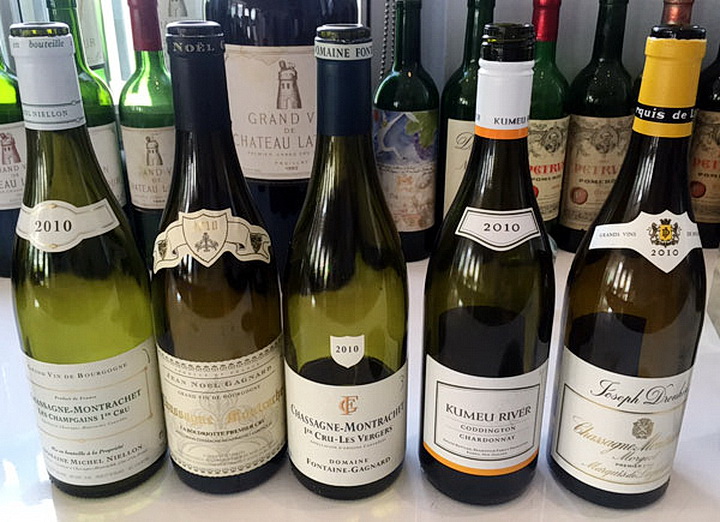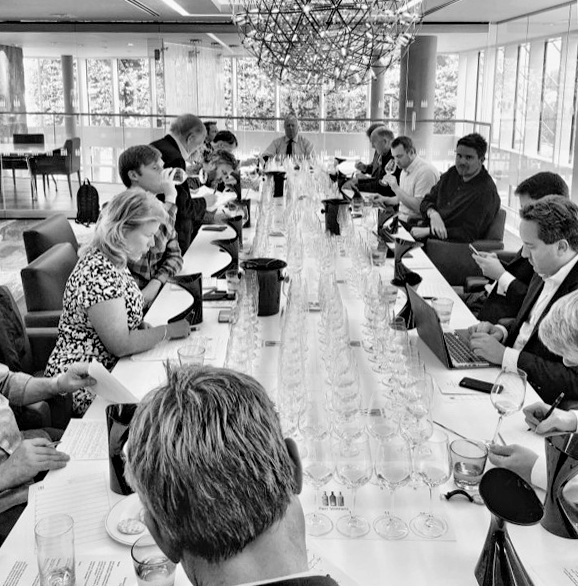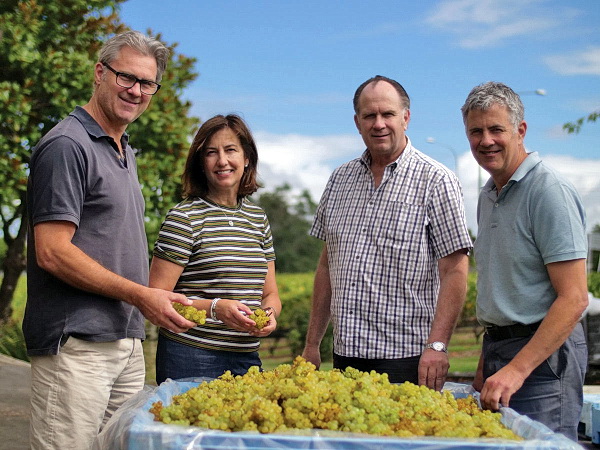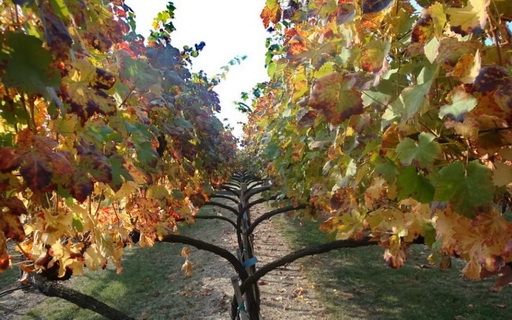August 2022 Update
I sent a link to this post to Kumeu River, asking for corrections. omissions and additions, and received an email from Michael Brajkovich the following day with a few of these. He thanked me and addedd that he was happy to answer any remaining questions I might have,
I was surprised at the rapid and comprehensive response from this brilliant winemaker who has received so much recognition from the top wine critics in the UK and USA. He really doesn’t need our blessing. This family is so well-grounded, and just so plain humble!
Montrachet
Yes, that’s the wine some of the world’s wine critics have compared these wines to great Burgundies, and they’re made in the suburbs of Auckland. I had a chance to taste some Kumeu River chardies with my best mate Reg who has long been a champion of this winery. The only wine they make that comes in under $20 is the Kumeu Village Chardonnay, which I’ve recommended many times in recent years.
It shows some of the seamless polish of the wines further up the scale, in a ready to go, easy on the gums frame. The KR Estate and the Ray’s Road from Hawke’s Bay fit in the under $50 group, while the Coddington, Hunting Hill and Maté’s Vineyard are around $65, $90 and $120. Given that they’ve beaten Grand Cru Burgundies in blind tastings that cost 10 times as much, they’re colossal bargains.
Fine wine merchants Farr Vintners in London have championed Kumeu River Chardonnays for about 25 years, and they arranged two blind tastings with the heavy hitters of the British wine trade, in 2015 and 2018. They put KR chardies up against white Burgundies costing many times as much.
4 Rounds with Heavyweights
Paul Brajkovich went to London in 2015 – while his brother Michael stayed at home and took care of winemaking – for the first blind tasting at Farr Vintners, which pitched KR’s chardies against top class Burgundies.
In the four flights of wine of the tasting (5 wines each), KR’s wines were outright winners in three, and came equal first in the fourth. The publicity this tasting generated made the English-speaking wine world sit up and take serious notice as you can imagine.
What a great result! Wild colonials showing up the aristocracy of Burgundy, makers of the best dry white wines in the world, and trouncing their precious labels in an international blind tasting. The Judgement of London.
Jancis Robinson, the grande dame of UK wine writers said, ‘the Kumeu wines shone because they were better made and more sophisticated. Perhaps the Brajkoviches are simply trying harder. It was not the performance of these inexpensive Kiwi wines that was shocking but the state of the white burgundies.’
She added that ‘every one of the Kumeu River wines was fresh as a daisy and clearly had a glorious future ahead of it.’
Jamie Goode’s take on the tasting was: ‘I think the first thing that most of us will have done straight after the tasting is to go online and see who has stocks of Kumeu River. They are sensationally good wines.’
Once More With Feeling
Farr Vintners ran a different tasting in 2018. I guess they had established the quality of the KR Chardonnays 3 years earlier, so this time it was a retrospective: a massive tasting of 12 vintages of KR wines, from 2006 to 2017. 48 wines in total. The tasting panel included Oz Clarke, Steven Spurrier, Jancis Robinson, Neal Martin and Will Lyons.
‘The result of this tasting was a clear winner for the quality and consistency of the wines from Kumeu River,’ wrote Michael Brajkovich in the Kumeu River blog. ‘The tasting ended with an ovation for the wines and the clear consensus that of the 48 wines presented there was not one poor bottle. This never happens in tastings of this nature.’
Jancis Robinson was elated. ‘I have long argued that New Zealand makes even better Chardonnay than Sauvignon Blanc,’ she said. ‘Kumeu River somehow manages to make some of not just New Zealand’s but the world’s finest Chardonnay from vineyards in the Auckland suburbs. Three years ago I participated in a professional blind tasting where Kumeu Chardonnays comprehensively knocked spots off some of the finest white Burgundies.’
Joss Fowler at Vinolent offered a sobering comparison: ‘It’s been a very long time since I tasted Coche-Dury Corton-Charlemagne, but I reckon that a punchy vintage of Maté’s Vineyard could take it on. And Maté’s Vineyard is less than £300 a case, compared with £1,000+ for a single bottle of Coche-Drury Corton-Charlemagne.’
You read that right, a thousand pounds for a single bottle. The most recent price I can find for this wine down under is $5000 a bottle.
40 Vintages and Counting
2021 was Michael Brajkovich’s 40th vintage at KR. Michael’s father Maté had been there to work with him until his death in 1992. Cellar master Nigel Tibbits continued to work with Michael; he joined KR in 1974 as a 16-year-old. 2023 will be his 50th vintage.
‘Nigel continues to do the sterling work he has always done,’ says Michael. ‘We have grown together in our roles over these 40 years and the evolution of the Kumeu River style has continued steadily over that time. Nigel has played a huge role in that.’
Michael says 2020 was the best vintage he has experienced at Kumeu River, and it’s bracketed by the outstanding 2019 and 2021 vintages. The Maté’s Vineyard Chardonnay 2020 was James Suckling’s wine of the Year [short video] with a perfect 100 point score (JS appears to have taken over from Robert Parker). How do the brothers Brajkovich keep their feet on the ground?
Michael studied winemaking at Roseworthy in the early 1980s, and worked a vintage in France. He became the second Master of Wine outside the UK (after Michael Hill Smith), and served as chair at both the Royal Adelaide (for 3 years) and the Air New Zealand wine shows (for 5 years) .
Kumeu River is a family business, with matriarch Melba heading up the firm, and the next generation doing the hard work.
From left to right: Paul, Marijana, Michael and Milan
Ten Questions with Milton Wordley is an interview with Michael Brajkovich that covers the family history and reveals lots of insights into how KR developed such a winning range of Chardonnays. And there are lots of photos of the family’s journey.
This extensive profile Peter Richards wrote for Decanter fills in more blanks, and provides time lines.
What makes KR Chardonnays so special?
Milan Brajkovich looks after the vineyards. He says, ‘We’ve always just made wines we like to drink. New World wines with an Old World twist, for a fair price. We focus on what we do best: Chardonnay. We didn’t choose Chardonnay – it chose us.’
Behind that simple statement lies a sharp focus on every aspect of making outstanding wines, which some people would describe as obsessive. It comes back to Jancis Robinson’s conclusion at one of the London tastings that the Kumeu wines shone because they were better made and more sophisticated than the best white Burgundies.
The Vineyard
Most serious winemakers will tell you that the quest for outstanding wines starts in the vineyard. The climate around Kumeu River is very close to that of Burgundy, but more humid due the proximity of the ocean – 15 kilometers to the west coast, and 20 kms the other way. It’s cool to moderate around here, with temperatures rarely exceeding 30 degrees C.
The soils on the other hand are nothing like those of Burgundy: heavy clay over sandstone, not gravel over limestone. The textbooks imply that this is not the best soil mix for producing wold class wines, but they’re clearly wrong. The soil at Kumeu River has the advantage of hanging onto enough water even during dry summers, so the vineyards don’t need irrigation which keeps yields low and the quality of fruit high.
The Lyre trellis system KR uses for the grape vines is no longer popular these days, as it doesn’t suit mechanical pruning and harvesting. Since the grapes at KR are picked by people and not machines, this is not an issue. The reason Micheal and Milan like the Lyre trellis system is that it reduces over-vigorous canopy growth and exposes the grapes to more sunshine, while the increased airflow reduces the chance of mildew forming. MORE HERE [3 min. video – an interview with Jamie Goode]
Winemaking
The fruit is hand-picked from low yielding vines, whole bunch pressed, and fermented with wild yeasts in French oak barriques. As the fruit arrives at the winery in bins, it is tipped straight into an air-bag press which is much gentler than the traditional crusher. The juice that comes out of the press is pretty clean, but requires some settling to clarify. It’s left overnight at 12 degrees C, then the clear juice is racked off, leaving behind less than 1% solids.
‘We will often also take some of the lighter golden-coloured lees to complex the fermentation,’ Micheal adds. ‘We are most concerned about leaving behind the heavy, easily removed, grape solids. These also contain most of the sulfur spray residues which lead to reductive characters in the ferment.’
After the primary fermentation, the wines go through a complete malolactic fermentation, which converts the green malic acid to softer lactic acid. This adds complexity and creamy texture to the wine. Buttery characters (caused by diacetyl) are avoided by extended maturation on yeast lees in barrel, well past the end of the malolactic fermentation.
‘[the malo] is pretty much a no-no with Chardonnay makers down under these days,’ says Michael. I agree wholeheartedly, as I’ve said more than once. Our young gun winemakers avoid the malo like the plague in their Chardonnays, or restrict it to a small portion of the finished wine.
That’s where the grapefruit tang comes from in mod-Oz chardies. The extended solids fermentation techniques they use also promote the struck match funk, that reductive sulfide character we see so much of in our up-market chardies these days.
Michael is no fan of that nonsense. He says, ‘it became very popular with winemakers both here and in Australia. But, true to the new world adage that if a little bit of something is good, then a whole lot more must be great, things went to extremes. Our wines have not changed in this regard, they have the same low-level reduction that they’ve had for many years. We have certainly not pursued the technique of full-solids fermentation, which maximises this effect, because we believe it also unbalances the wine.’
Balance is something KR chardies have plenty of. The wines are matured in French oak barriques, some of them new, and the oak integration is exemplary; it doesn’t poke out even in the young wines, the way it does in expensive white Burgundies. In short, KR Chardonnays are made to let the superb fruit do the talking.
Michael stresses the importance of the Mendoza Chardonnay clone in Maté’s vineyard. This clone is famous for producing ‘Hen & Chicken’ fruit sets in bunches of grapes, also known as millerandage. The result is small berries and normal-sized ones on the same bunch, which adds a richer texture and more complexity to the finished wine.
Mendoza is a close relative of the Gingin clone used in Margaret River. Professor Harold Olmo brought it with him from California when he was consulting to the W.A. agriculture department’s Bill Jamieson at the dawn of the Margaret River wine region. Various clones have been carefully selected for each of KR’s vineyards.
To sum up, what makes KR Chardonnays so special is the painstaking attention they receive at every stage of production. It’s labour intensive and costly, and doesn’t follow current winemaking fads. One gets the impression that Michael, Milan and Nigel Tibbits have been working with an unerring compass which they calibrated to perfection over many years.
The Future
Kumeu River is clearly an operation at the very top of its game. The demand for its wines has never been stronger, which has resulted in limited allocations so that every market will at least get some of the wines.
Auckland’s urban sprawl has engulfed Kumeu River’s original vineyard, which is a mere 30 minute drive from the centre of Auckland. As a result of spiraling land prices, expansion of the 30-hectare vineyard is not feasible.
That’s why the family bought the Ray’s Road vineyard in Hawke’s Bay when it came up for sale a few years ago. The Coddington vineyard is also in the way of the suburban tsunami, but the Brajkovichs have signed a 5-year lease with the new owners so its immediate future is safeguarded.
How long can the Brajkovichs hold on in the face of rising values for their land? At some point the economics of their position will force the issue, so I expect that KR will buy or lease more vineyards further afield.
I suspect that the critical factor for their success is their 40 years of experience making great Chardonnays, and this experience is transferable as long as the terrain and climate are suitable. New Zealand seems to have plenty of both in abundance.
Right now, these wines present outstanding value. Their quality is up there with the best Chardonnays from Burgundy and the Napa Valley, so my advice is this: scratch together all your spare pennies and buy whatever 2020 KR wines are left in the marketplace. Winesquare, Wineaway, Summer Hill Wine, The Vine Press, Grevillea Wine, The Wine Collective and Prince Wine Store have minute quantities of some of the 2020s left at the time of writing – July 2022.
Save some money for the 2021 though, the third great vintage in a row at Kumeu River, and Michael’s 40th.
These wines are becoming ever harder to find because of their limited production, and their growing fame worldwide.
MORE READING / VIEWING





